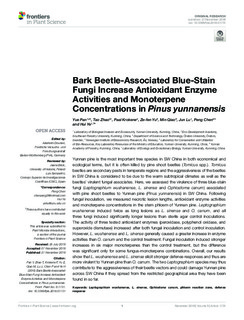| dc.contributor.author | Pan, Yue | |
| dc.contributor.author | Zhao, Tao | |
| dc.contributor.author | Krokene, Paal | |
| dc.contributor.author | Yu, Ze-fen | |
| dc.contributor.author | Qiao, Min | |
| dc.contributor.author | Lu, Jun | |
| dc.contributor.author | Chen, Peng | |
| dc.contributor.author | Ye, Hui | |
| dc.coverage.spatial | China | nb_NO |
| dc.date.accessioned | 2018-12-11T11:24:18Z | |
| dc.date.available | 2018-12-11T11:24:18Z | |
| dc.date.created | 2018-11-27T10:07:40Z | |
| dc.date.issued | 2018-11-27 | |
| dc.identifier.citation | Frontiers in Plant Science. 2018, 9 . | nb_NO |
| dc.identifier.issn | 1664-462X | |
| dc.identifier.uri | http://hdl.handle.net/11250/2577097 | |
| dc.description.abstract | Yunnan pine is the most important tree species in SW China in both economical and ecological terms, but it is often killed by pine shoot beetles (Tomicus spp.). Tomicus beetles are secondary pests in temperate regions and the aggressiveness of the beetles in SW China is considered to be due to the warm subtropical climates as well as the beetles’ virulent fungal associates. Here, we assessed the virulence of three blue-stain fungi (Leptographium wushanense, L. sinense and Ophiostoma canum) associated with pine shoot beetles to Yunnan pine (Pinus yunnanensis) in SW China. Following fungal inoculation, we measured necrotic lesion lengths, antioxidant enzyme activities and monoterpene concentrations in the stem phloem of Yunnan pine. Leptographium wushanense induced twice as long lesions as L. sinense and O. canum, and all three fungi induced significantly longer lesions than sterile agar control inoculations. The activity of three tested antioxidant enzymes (peroxidase, polyphenol oxidase, and superoxide dismutase) increased after both fungal inoculation and control inoculation. However, L. wushanense and L. sinense generally caused a greater increase in enzyme activities than O. canum and the control treatment. Fungal inoculation induced stronger increases in six major monoterpenes than the control treatment, but the difference was significant only for some fungus-monoterpene combinations. Overall, our results show that L. wushanense and L. sinense elicit stronger defense responses and thus are more virulent to Yunnan pine than O. canum. The two Leptographium species may thus contribute to the aggressiveness of their beetle vectors and could damage Yunnan pine across SW China if they spread from the restricted geographical area they have been found in so far. | nb_NO |
| dc.language.iso | eng | nb_NO |
| dc.rights | Navngivelse 4.0 Internasjonal | * |
| dc.rights.uri | http://creativecommons.org/licenses/by/4.0/deed.no | * |
| dc.subject | Leptographium wushanense, | nb_NO |
| dc.subject | L. sinense | nb_NO |
| dc.subject | Ophiostoma canum | nb_NO |
| dc.subject | Phloem reaction zone | nb_NO |
| dc.title | Bark Beetle-Associated Blue-Stain Fungi Increase Antioxidant Enzyme Activities and Monoterpene Concentrations in Pinus yunnanensis | nb_NO |
| dc.type | Journal article | nb_NO |
| dc.type | Peer reviewed | nb_NO |
| dc.description.version | publishedVersion | nb_NO |
| dc.rights.holder | © 2018 Pan, Zhao, Krokene, Yu, Qiao, Lu, Chen and Ye. | nb_NO |
| dc.source.pagenumber | 10 | nb_NO |
| dc.source.volume | 9 | nb_NO |
| dc.source.journal | Frontiers in Plant Science | nb_NO |
| dc.identifier.doi | 10.3389/fpls.2018.01731 | |
| dc.identifier.cristin | 1635566 | |
| cristin.ispublished | true | |
| cristin.fulltext | original | |
| cristin.qualitycode | 1 | |

